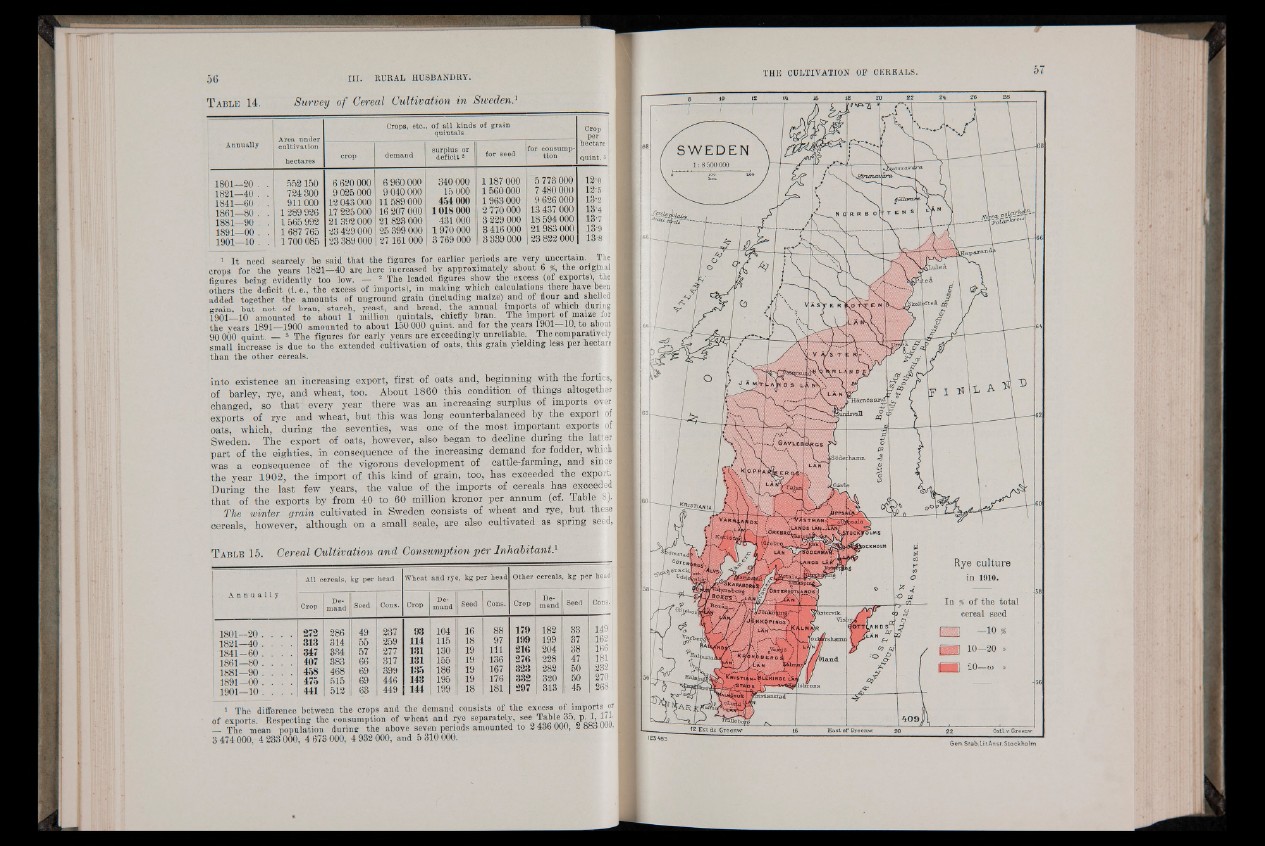
5G III. RURAL HUSBANDRY.
T a b l e 14. Survey of Cereal Cultivation in Sweden}
Annually
Area under
cultivation
hectares
Crops, etc. of a ll kinds
quintals
of grain Crop ]
per
hectare |
surplus or
crop demand deficit 2 for seed
qu in t.3 for consumption
1801—20 . . 552150 6 620 000 6 960 000 340 000 1187 000 5 773 000 12'0
1821—40 . . 724 300 9 025 000 9 040 000 15 000 1560 000 7 480 000 12*5
1841—60 . . 911 000 12 043 000 11589 000 454000 1 963 000 9 626 000 13-2
1861—80 . . 1289 926 17 225 000 16 207 000 1018 000 2 770 000 13 437 000 134
1 1881—90 . . 1 565 992 21 392 000 21 823 000 431000 3 229 000 18 594 000 13-7
I 1891—00 . . . 1 687 765 23 429 000 25 399 000 1970 000 3 416 000 21 983 000 13'9
i 1901—10 . . 1700 085 23 389 000 27 161000 3 769 000 3 339 000 23 822 000 13'8
1 It need scarcely be said that the figures for earlier periods are very uncertain. _ The
crops for the years 1821—40 are here increased by approximately about 6 %, the original
figures being evidently too low. - • 2 The leaded figures show the'excess (of exports), the
others the deficit (i.e., the excess of imports), in making which calculations there have been
added together the amounts of unground grain (including maize) and of flour and shelled
o-rain. but not of bran, starch, yeast, and bread, the annual imports of which during j
1901—10 amounted to about 1 million quintals, chiefly bran. The import of maize for
the years 1891—1900 amounted to about 150 000 quint, and for the years 1901—10, to about
90 000 quint. — 3 The figures for early years are exceedingly unreliable. The comparatively
small increase is due to the extended cultivation of oats, this grain yielding less per hectare
than the other cereals.
into existence an increasing export, first of oats and, beginning with the forties, j
of barley, rye, and wheat, too. About 1860 this condition of things altogether j
changed, so that'' every year there was an increasing surplus of imports over
exports ’of rye and wheat, but this was long counterbalanced by the export of j
oats, which, during the seventies, was one of the most important exports of
Sweden. The export of oats, however, also began to decline during the latter
part of the eighties, in consequence of the increasing demand for fodder, which
was a consequence of the vigorous development of cattle-farming, and since j
the year 1902, the import of this kind of grain, too, has exceeded the export.
During the last few years, the value of the imports of cereals has exceeded!
that of the exports by from 40 to 60 million kronor per annum (cf. Table|8).
The winter grain cultivated in Sweden consists of wheat and rye, but these
cereals, however, although on a small scale, are also cultivated as spring ||sed,
T a b l e 15. Cereal Cultivation and Consumption per Inhabitant}
A n n u a l l y
All cereals, kg per head Wheat and rye, kg peT head Other cereals, kg per head
maud Seed Cons. Crop Domand
Crop De- . ,
Seed Cons. Crop Demand
Seed ■Cons. 1
1801—20 . . . . 272 286 49 237 93 104 16 88 179 '482 33 149
1821 40 . 313 314. 55 259 114 115 18 97 199 199 3V 162
1841—60 . . . . 347 334 57 277 131 130 19 111 216 204 38 pi66
1861—80 . . . . 407 383 66 317 131 155 19 136 276 228 47 181
1881 90 . . . 458 468 69 399 135 186 19 167. 323 282 bO 232
1891 00 . . . . 515 69 446 143 195 19 176 332 320 50 270
1901—10 . . . . 441 512 1 63 449 144 199 18 181 : 297 313 4.5 268
1 The difference between the crops and the demand consists of the excess o f i m p o r t s or
of exports. Respecting the consumption of wheat and rye separately, jsee Table 35, p. I, 171.
— The mean population during the above seven periods amounted to 2 4db 000, 2 880 IW
3 474 000 4 233 000, 4 673 000, 4 932 000, and 5 310 000.